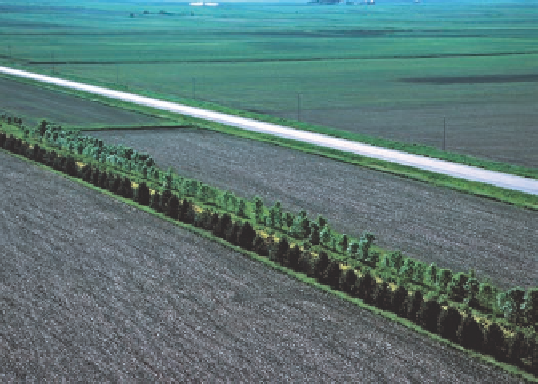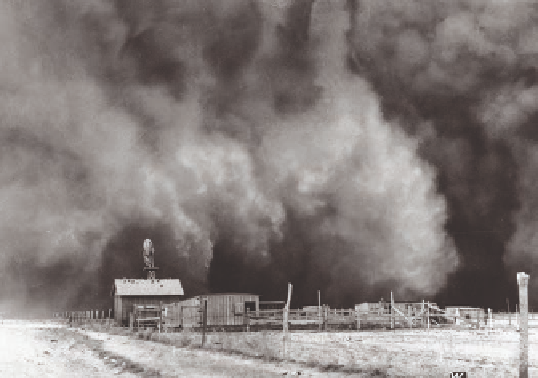Geoscience Reference
In-Depth Information
it would rain more in this semi-arid land because water stored
within the soil would be released and thus fall immediately
back to Earth. Fueled in part by this myth, as well as a strong
sense of rugged individualism, the settlers gradually converted
progressively larger tracts of native grassland to farmland by
plowing it up (Figure 10.32).
As settlement in the area progressed, the first few decades
were sufficiently wet to give farmers reason for hope in their
economic future. Many even believed that it was indeed rain-
ing more because much of the grassland had been plowed. A
drought in the early 1890s caused some concern, but was not
overly extreme because favorable environmental conditions
quickly returned and wheat harvests rebounded. Confidence
grew, which promoted further plowing and planting. With the
advent of World War I in the 1910s, wheat prices surged due
to crop shortages in Europe, and even more land was plowed
and converted to wheat acreage. After the war ended, however,
wheat prices crashed. In response, farmers converted even the
marginal lands to wheat in an effort to make up the price dif-
ferential. The net effect, however, was to reduce wheat prices
even more because supply drastically exceeded demand. By
this point, virtually the entire prairie had been plowed, and the
land lay bare of the grassland that had protected it for thousands
of years.
Disaster struck in the early 1930s when the region was
crippled by a searing drought that lasted for several years.
Precipitation in many parts of the region was less than half of
the
∙
50 cm (
∙
20 in.) per year that normally fell and crops failed
everywhere. Such an intense drought would have impacted the
landscape, perhaps through the remobilization of small dune
fields, even if it had occurred during the pre-settlement period
when the ground was covered with grass. On the other hand,
the deep-rooted native grasslands would have protected the soil
in most places. Given that most of the grass had been plowed
under in the preceding few decades, however, the soils were
utterly exposed and thus easily deflated by the very high winds
that accompanied the drought.
Given the exposed soils and high winds, the region was
pounded by crippling dust storms (Figure 18.32) throughout
much of the 1930s. Such storms repeatedly blasted an area
about 400,000 km
2
(
∙
155,000 mi
2
) in size and were so intense
that they were called
black blizzards
. Perhaps 800 million tons
of dust was blown from the Plains and carried as far as Chicago
and Washington, D.C. The dust was so thick in Kansas City that
streetlights were often left on during daylight hours. Perhaps
the worst of it occurred on April 14, 1935 when 20 such storms
occurred throughout the region, turning day into night and re-
ducing visibility to less than 2 m (
∙
6 ft). No wonder this day
is now referred to as Black Sunday. Overall, about 350 such
storms occurred from 1937 and the first nine months of 1937.
Can you imagine what it must have been like to live there?
The overall result of the drought was to desertify the land-
scape in much of the region. From a cultural and economic
standpoint, the impact was devastating, with many families left
literally on the verge of starvation. Many hundreds of people
also contracted
dust pneumonia
from inhaling too much fine
Figure 18.32 A black blizzard during the Dust Bowl.
Dust
storms in the Great Plains, such as this one in Oklahoma, were
common during the 1930s. These massive storms resulted from
the combined impacts of drought, high winds, and plowed soils.
sediment, with young and old alike succumbing to the condi-
tion. Although many people chose to stay and hope for rain,
large numbers moved out of the region in search of a better life.
Over 200,000 of these refugees migrated to California, as de-
picted in John Steinbeck's famous novel,
The Grapes of Wrath
.
By 1940 over two million people had left the Plains states, with
some counties losing over half the population.
The environmental catastrophe associated with the Dust
Bowl prompted the federal government's first systematic effort
to promote environmental conservation. As discussed in Chapter
11, the U.S. government established the Soil Erosion Service
in 1933 (now the NRCS) to promote soil conservation in the
region. Farmers were taught to plow and terrace their fields in
ways to control soil erosion, as well as to plant
windbreaks
on
the edge of fields to block the wind (Figure 18.33). They also
Figure 18.33 A conservation windbreak.
Windbreaks such as
this one are rows of tall trees planted along fields that block the
wind from blowing directly across the ground.



